Frequency Alteration Built on an Electro-Optical Sampling SOA–MZI Using a Differential Modulation Schema
Abstract
:1. Introduction
2. Electro-Optical Sampling Principle of Differential Modulation Architectonic
3. Setup Characterization Used in a VPI Simulator
4. Experimental Setup Characterization
5. Conclusions
Author Contributions
Funding
Institutional Review Board Statement
Informed Consent Statement
Data Availability Statement
Conflicts of Interest
References
- Kleine-Ostmann, T.; Nagatsuma, T. A Review on Terahertz Communications Research. J. Infrared Millim. Terahertz Waves 2011, 32, 143–171. [Google Scholar] [CrossRef]
- Rouvalis, E.; Renaud, C.; Moodie, D.G.; Robertson, M.J.; Seeds, A.J. Traveling-wave Uni-Traveling Carrier Photodiodes for continuous wave THz generation. Opt. Express 2010, 18, 11105–11110. [Google Scholar] [CrossRef] [PubMed]
- Preu, S.; Döhler, G.H.; Malzer, S.; Wang, L.J.; Gossard, A.C. Tunable, continuous-wave Terahertz photomixer sources and applications. J. Appl. Phys. 2011, 109, 061301. [Google Scholar] [CrossRef] [Green Version]
- Thomas, V.A.; El-Hajjar, M.; Hanzo, L. Millimeter-Wave Radio Over Fiber Optical Upconversion Techniques Relying on Link Nonlinearity. IEEE Commun. Surv. Tutor. 2016, 18, 29–53. [Google Scholar] [CrossRef] [Green Version]
- Hassan, T.; Ali, N. Real & Simulated QPSK Up-Converted Signals by a Sampling Method Using a Cascaded MZMs Link. Photonics 2022, 9, 34. [Google Scholar] [CrossRef]
- Chul, S.P.; Choong, K.; Chung, G.L.; Dong-Hwan, K.; Chang-Soo, P. A photonic up-converter for a WDM radio-over-fiber system using cross-absorption modulation in an EAM. IEEE Photonics Technol. Lett. 2005, 17, 1950–1952. [Google Scholar] [CrossRef]
- Thouras, J.; Benazet, B.; Leblond, H.; Aupetit-Berthelemot, C. Photonic radio frequency down-converter based on parallel electro-absorption modulators in Ku/Ku band for space applications. In Proceedings of the 2016 21st OptoElectronics and Communications Conference (OECC) Held Jointly with 2016 International Conference on Photonics in Switching (PS), Niigata, Japan, 3–7 July 2016; pp. 576–578. [Google Scholar]
- Ahmad, W.M.; Haymen, S.C.L.; Chris, G.; Michele, N.; Alwyn, J.S.; Cyril, C.R. 60-GHz Transmission link using uni-traveling carrier photodiodes at the transmitter and the re-ceiver. J. Lightwave Technol. 2018, 36, 4507–4513. [Google Scholar]
- Rouvalis, E.; Fice, M.; Renaud, C.; Seeds, A.J. Millimeter-Wave Optoelectronic Mixers Based on Uni-Traveling Carrier Photodiodes. IEEE Trans. Microw. Theory Tech. 2012, 60, 686–691. [Google Scholar] [CrossRef]
- Bohemond, C.; Rampone, T.; Sharaiha, A. Performances of a Photonic Microwave Mixer Based on Cross-Gain Modulation in a Semiconductor Optical Amplifier. J. Lightwave Technol. 2011, 29, 2402–2409. [Google Scholar] [CrossRef]
- Termos, H.; Rampone, T.; Sharaiha, A.; Hamié, A.; Alaeddine, A. All-Optical Radiofrequency Sampling Mixer Based on a Semiconductor Optical Amplifier Mach–Zehnder Interferometer Using a Standard and a Differential Configuration. J. Lightwave Technol. 2016, 34, 4688–4695. [Google Scholar] [CrossRef]
- Termos, H.; Rampone, T.; Sharaiha, A.; Hamié, A. Up and down frequency conversion of a QPSK signal by an all-optical radiofrequency sampling mixer based on a semiconductor optical amplifier Mach-Zehnder interferometer. In Proceedings of the 2015 International Topical Meeting on Microwave Photonics (MWP), Paphos, Cyprus, 25–29 October 2015; pp. 1–4. [Google Scholar]
- Termos, H.; Rampone, T.; Sharaiha, A.; Hamie, A.; Alaeddine, A. OFDM signal up and down frequency conversions by a sampling method using a SOA-MZI. In Proceedings of the 2017 29th International Conference on Microelectronics (ICM), Beirut, Lebanon, 10–13 December 2017; pp. 1–5. [Google Scholar]
- Termos, H.; Rampone, T.; Sharaiha, A. Sampling rate influence in up and down mixing of QPSK and OFDM signals using an SOA-MZI in a differential configuration. Electron. Lett. 2018, 54, 990–991. [Google Scholar] [CrossRef]
- Termos, H.; Mansour, A.; Nasser, A. Simultaneous up- and down-frequency mixing based on a cascaded SOA-MZIs link. Appl. Opt. 2021, 60, 8336–8348. [Google Scholar] [CrossRef] [PubMed]
- Hassan, T.; Ali, M.; Abbass, N. Simultaneous Up-Conversion Based on a Co- & Counter-Directions SOA-MZI Sam-pling Mixer with Standard & Differential Modulation Modes. Photonics 2022, 9, 109. [Google Scholar] [CrossRef]
- Termos, H.; Mansour, A. OFDM signal down frequency conversion based on a SOA-MZI sampling mixer using differ-ential modulation and switching architectures. Opt.-Int. J. Light Electron Opt. 2021, 245, 167761. [Google Scholar] [CrossRef]
- Song, H.-J.; Lee, J.S.; Song, J.-I. Signal up-conversion by using a cross-phase-modulation in all-optical SOA-MZI wave-length converter. IEEE Photon. Technol. Lett. 2004, 16, 593–595. [Google Scholar] [CrossRef]
- Kim, H.-J.; Lee, S.-H.; Song, J.-I. Generation of a 100-GHz opticalSSB signal using XPM-based all-optical frequency up-conversion in an SOAMZI. Microw. Opt. Technol. Lett. 2014, 57, 35–38. [Google Scholar] [CrossRef]
- Kim, D.-H.; Lee, J.-Y.; Choi, H.-J.; Song, J.-I. All-optical single sideband frequency up conversion utilizing the XPM effect in an SOAMZI. Opt. Express 2016, 24, 20309–20317. [Google Scholar] [CrossRef]
- Capmany, J.; Sales, S.; Pastor, D.; Ortega, B. Optical mixing of microwave signals in a nonlinear semiconductor laser am-plifier modulator. Opt. Express 2002, 10, 183–189. [Google Scholar] [CrossRef]
- Bohémond, C.; Sharaiha, A.; Rampone, T.; Khaleghi, H. Electro-optical radiofrequency mixer based on semiconductor optical amplifier. Electron. Lett. 2011, 47, 331–333. [Google Scholar] [CrossRef]
- Rampone, T.; Zulma, R.; Sharaiha, A. Electro-optical radiofrequency up-converter based on a semiconductor optical am-plifier. In Proceedings of the 2011 International Topical Meeting on Microwave Photonics Jointly Held with the 2011 Asia-Pacific Microwave Photonics Conference, Singapore, 18–21 October 2011; Volume 31, pp. 145–148. [Google Scholar]
- Wang, J.; Rong, J.; Yu, L. Dynamic prescribed performance sliding mode control for DC–DC buck converter system with mismatched time-varying disturbances. ISA Trans. 2022. [Google Scholar] [CrossRef]
- Gomes, N.J.; Monteiro, P.P.; Gameiro, A. Next Generation Wireless Communications Using Radio over Fiber; Wiley: Hoboken, NJ, USA, 2012. [Google Scholar]
- VPI Transmission Maker/VPI Component Maker, User’s Manual, Photonic Modules Reference Manuals. VPI Photonics Official Website. Available online: http://www.vpiphotonics.com (accessed on 1 July 2022).
- Schmogrow, R.; Nebendahl, B.; Winter, M.; Josten, A.; Hillerkuss, D.; Koenig, S.; Meyer, J.; Dreschmann, M.; Huebner, M.; Koos, C.; et al. Error Vector Magnitude as a Performance Measure for Advanced Modulation Formats. IEEE Photonics Technol. Lett. 2011, 24, 61–63. [Google Scholar] [CrossRef]
- Mestre, M.A.; Mardoyan, H.; Caillaud, C.; Rios-Müller, R.; Renaudier, J.; Jennevé, P.; Blache, F. Compact InP-based DFB-EAM enabling PAM-4 112 Gb/s transmission over 2 km. J. Lightwave Technol. 2016, 34, 1572–1578. [Google Scholar] [CrossRef]
- 3GPP TS 36.104, Base Station (BS) Radio Transmission and Reception, Version 14.3.0 Release 14. 2017. Available online: https://www.etsi.org/deliver/etsi_ts/136100_136199/136104/14.03.00_60/ts_136104v140300p.pdf (accessed on 1 July 2022).
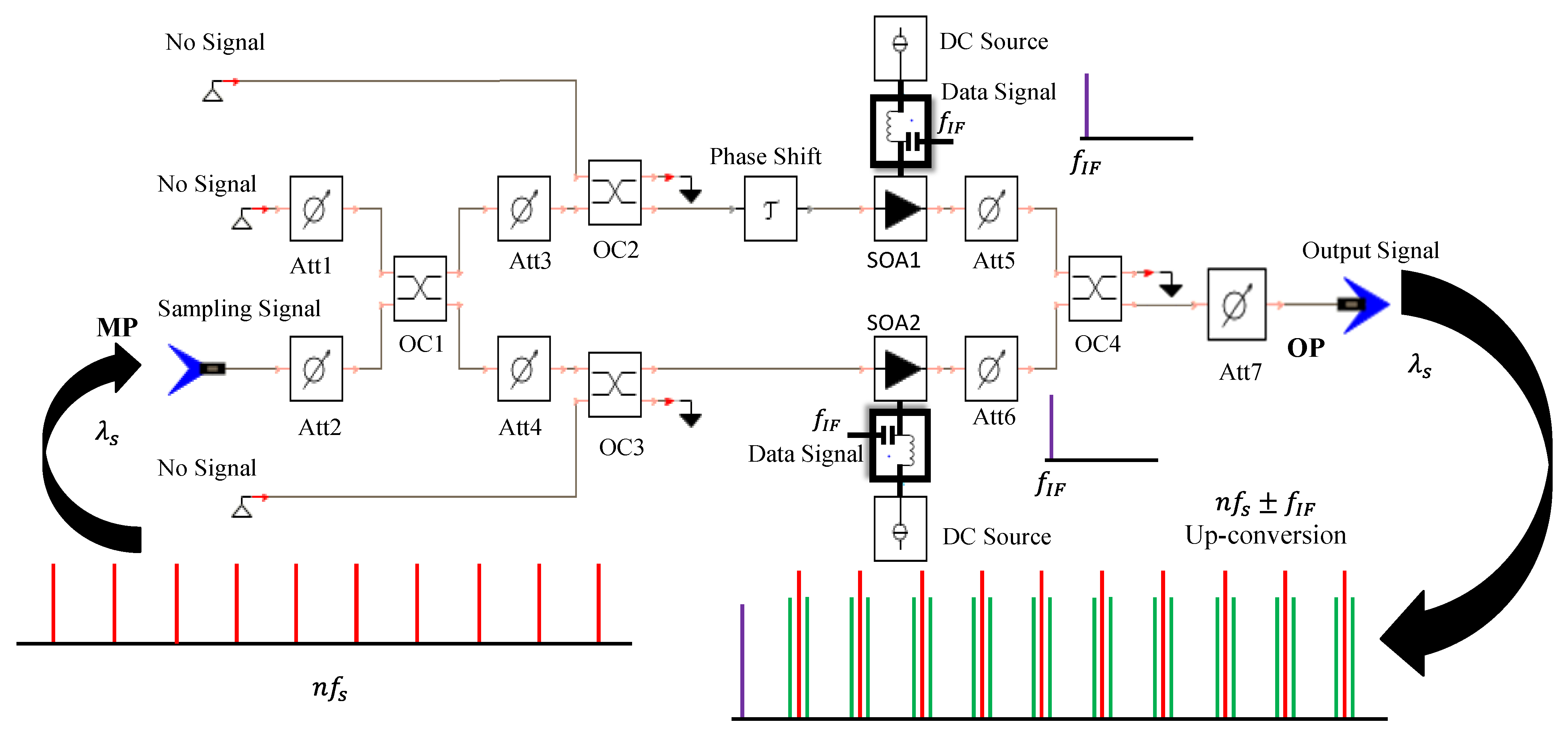
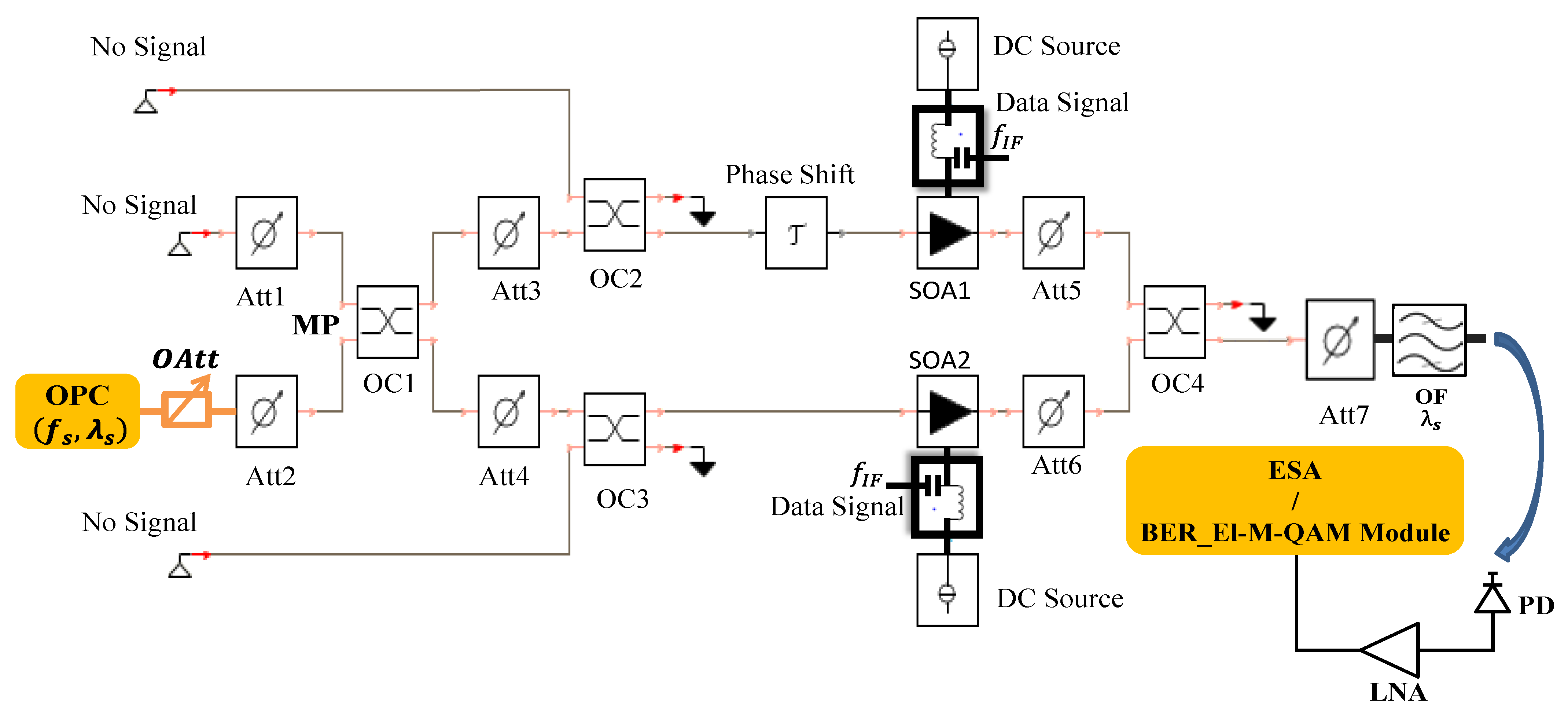
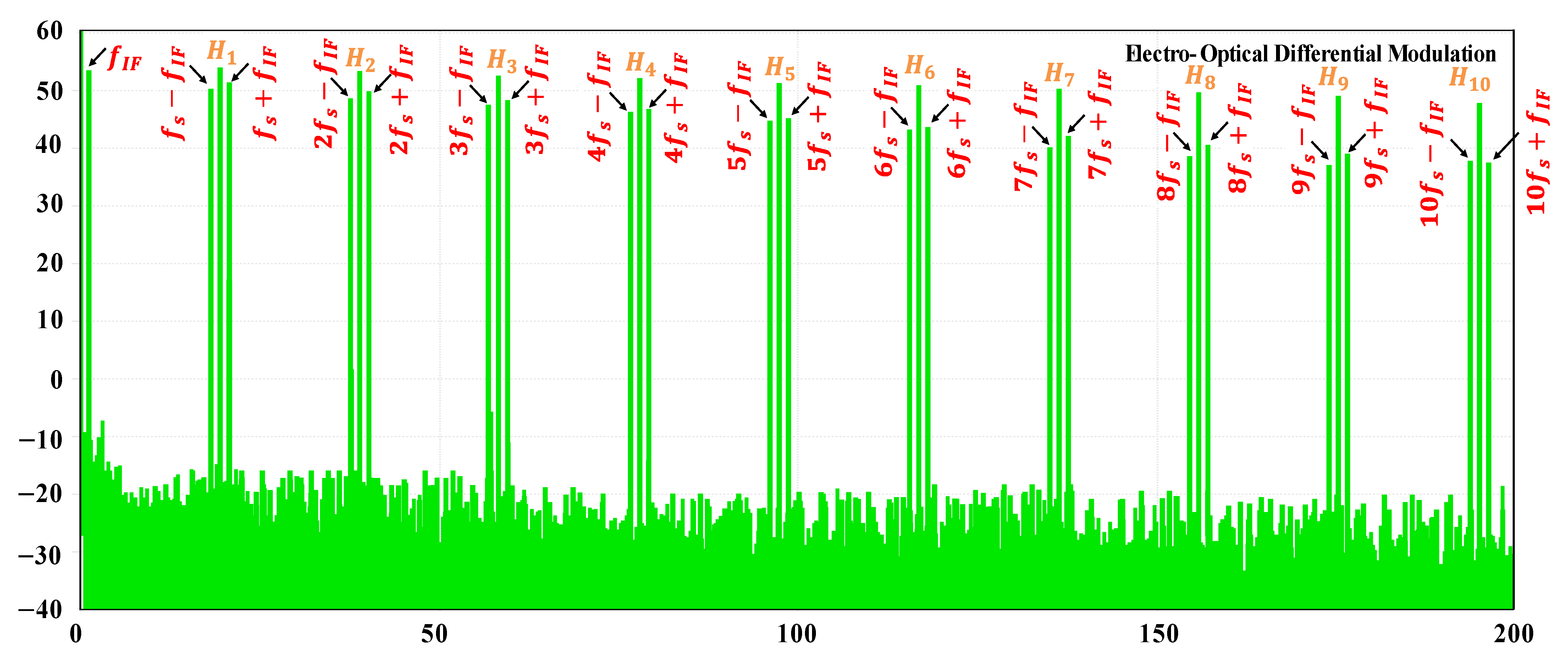
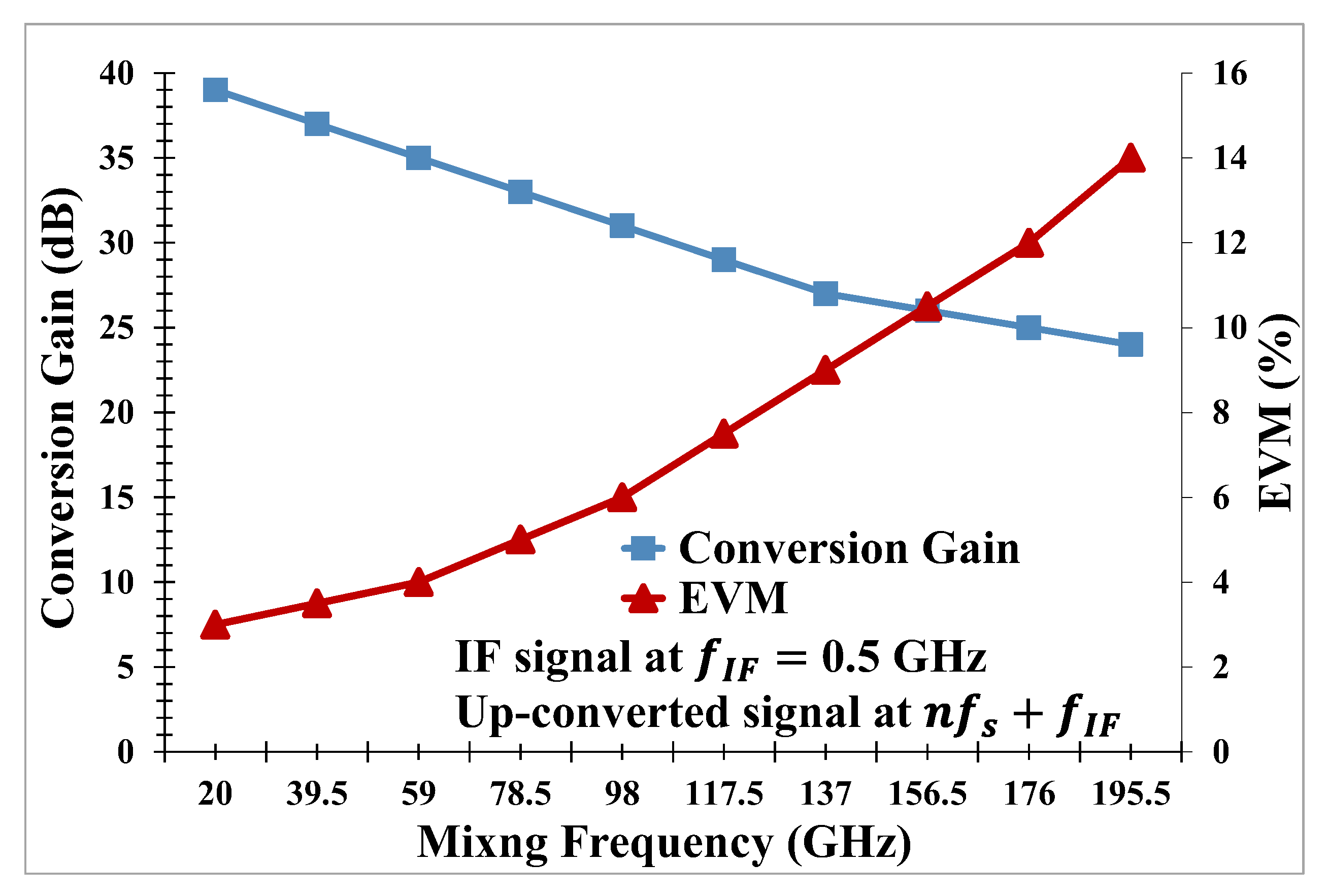
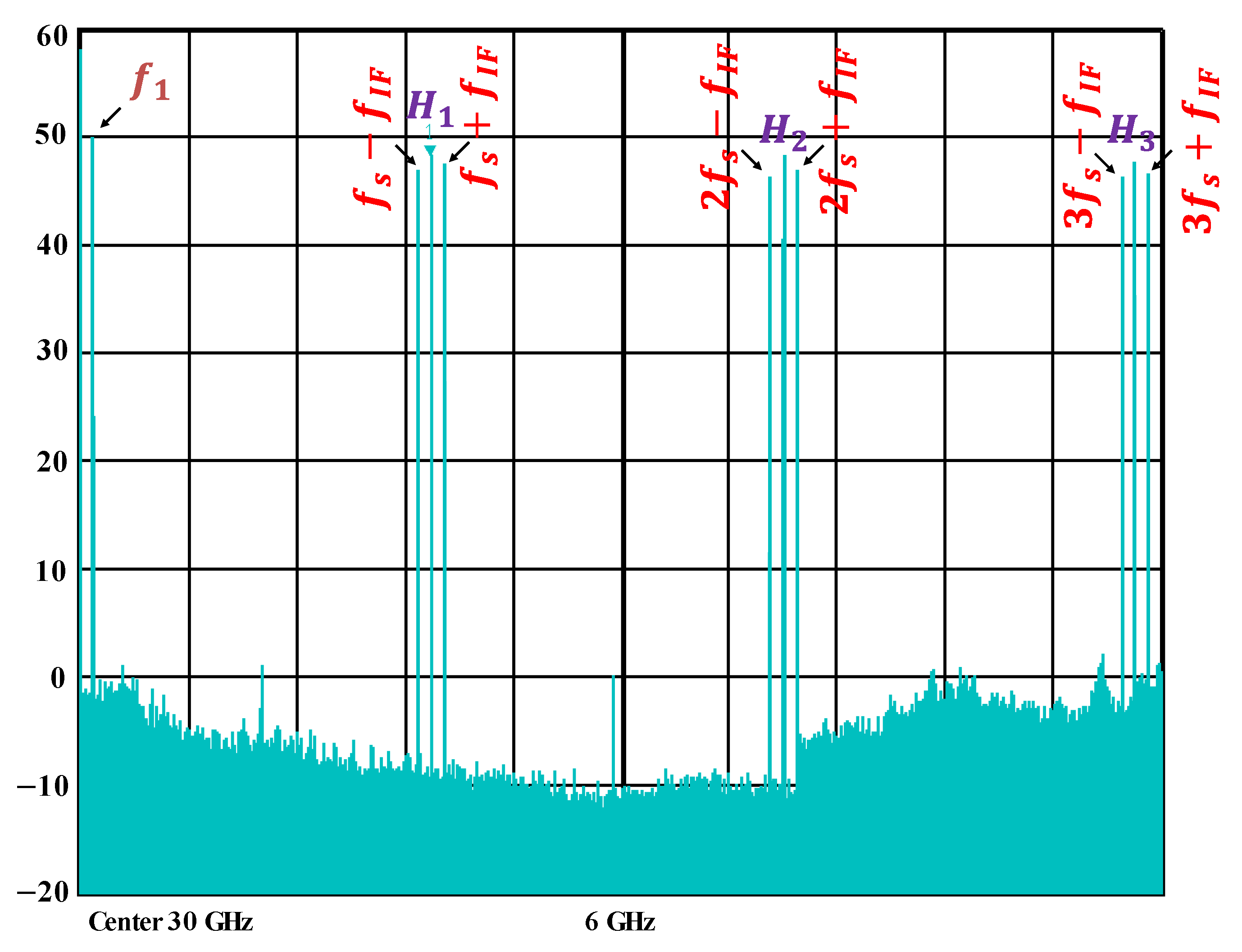
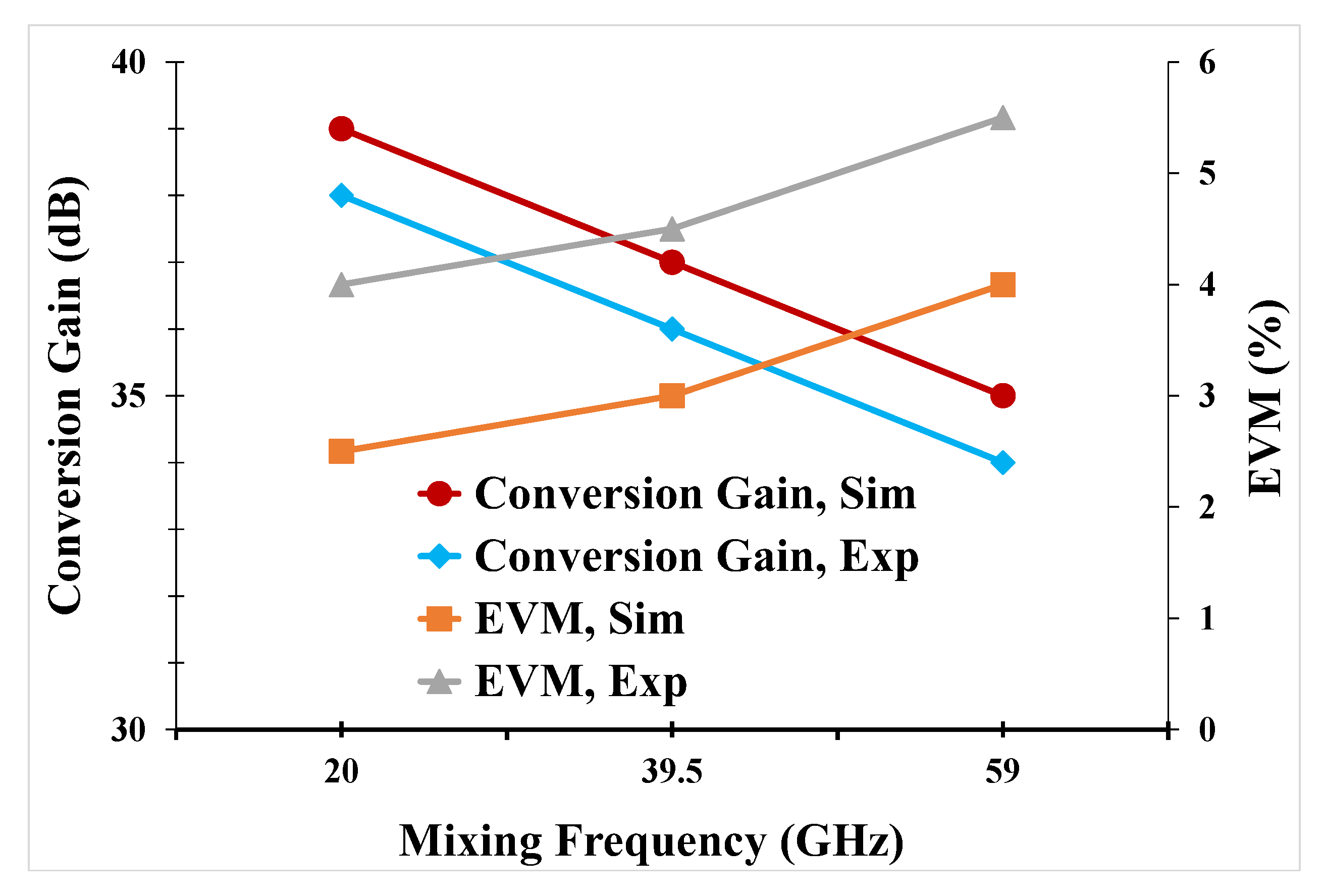
| Results | |||
|---|---|---|---|
| Reality | Simulations | ||
| Frequency Range (GHz) | = 59 | = 59 | = 195.5 |
| Conversion gain (dB) | 34 | 35 | 24 |
| EVM (%) | 5.5 | 4 | 14 |
Publisher’s Note: MDPI stays neutral with regard to jurisdictional claims in published maps and institutional affiliations. |
© 2022 by the authors. Licensee MDPI, Basel, Switzerland. This article is an open access article distributed under the terms and conditions of the Creative Commons Attribution (CC BY) license (https://creativecommons.org/licenses/by/4.0/).
Share and Cite
Termos, H.; Mansour, A. Frequency Alteration Built on an Electro-Optical Sampling SOA–MZI Using a Differential Modulation Schema. Optics 2022, 3, 225-233. https://doi.org/10.3390/opt3030022
Termos H, Mansour A. Frequency Alteration Built on an Electro-Optical Sampling SOA–MZI Using a Differential Modulation Schema. Optics. 2022; 3(3):225-233. https://doi.org/10.3390/opt3030022
Chicago/Turabian StyleTermos, Hassan, and Ali Mansour. 2022. "Frequency Alteration Built on an Electro-Optical Sampling SOA–MZI Using a Differential Modulation Schema" Optics 3, no. 3: 225-233. https://doi.org/10.3390/opt3030022
APA StyleTermos, H., & Mansour, A. (2022). Frequency Alteration Built on an Electro-Optical Sampling SOA–MZI Using a Differential Modulation Schema. Optics, 3(3), 225-233. https://doi.org/10.3390/opt3030022







